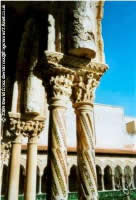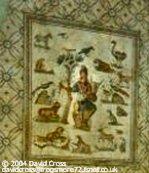All long-distance buses seem to have termini fairly near the Central Station [trains]. Outside this there is a massive square where most local buses start and from the other side there are roads into the centre, of which the Via Roma is the widest. The place where I stayed is just to the left of the Via Roma [third turn] and is visible from it. This is the Rosalia Conco d’Oro, completely unprepossessing from outside but snug, clean, comfortable and friendly inside and with a lift to the third floor reception and rooms. Toilets and showers are shared but I never had to wait.
However short your time here, there is one thing which is simply NOT TO BE MISSED, the Duomo at Monreale. This means one of the buses which does not start from the station and it is necessary to get first to the Piazza del’Indepenza to catch it. [Bus #309 from the station.] Words fail me at describing the appeal of this cathedral and I am happy to quote from the Rough Guide ‘the most extraordinary and extensive area of Christian medieval mosaicwork in the world, the apex of Sicilian-Norman art.’ I certainly cannot envisage anything better. To me this is one of the sights of Europe. Although totally different in style, I should place it in the same quality box as the Alhambra.
 This Duomo must have been quite
remarkable in the twelfth century for the dazzling speed of its construction.
It is believed that it was done and dusted within twelve years. The reason
for this would appear to have been political rivalry between the king and an
archbishop but it does leave us now with a whole building of a single style.
I regarded this visit as being of great historical interest as I had seen
nothing of this type of Greek and Byzantine workmanship, but I did not expect
it to appeal to me artistically. Talk about being bowled over; the impact of
the view of the interior on entry was like a physical blow. Although I have
seen nothing of its type to equal it, it has left me ready to appreciate a
much wider artistic range of church interiors.
This Duomo must have been quite
remarkable in the twelfth century for the dazzling speed of its construction.
It is believed that it was done and dusted within twelve years. The reason
for this would appear to have been political rivalry between the king and an
archbishop but it does leave us now with a whole building of a single style.
I regarded this visit as being of great historical interest as I had seen
nothing of this type of Greek and Byzantine workmanship, but I did not expect
it to appeal to me artistically. Talk about being bowled over; the impact of
the view of the interior on entry was like a physical blow. Although I have
seen nothing of its type to equal it, it has left me ready to appreciate a
much wider artistic range of church interiors.
I suppose the crowning glory in terms of art must be the mighty mosaic of Christ – ‘mighty’ not used lightly here as the head and shoulders are a good sixty feet high! I think, however that the ones that moved me once were those of most of the best known Old Testament accounts which go all around just below the high windows of the nave. Some real humour is very visible in the sections on the Creation and Noah’s Ark. Lastly, on the subject of this cathedral, do not on any account miss seeing the cloisters. I forget whether the entrance is on the same wall as that to the cathedral or the wall to the right hand side as you face it, but it is worth finding.
 There are some wonderful
mosaics elsewhere in Palermo as well. The church of La Martorana near the
centre has some of these and is probably one of the first things to see in
Palermo. However do not miss seeing the church next to it as well, the little
twelfth century chapel of San Cataldo. This is innocent of mosaics, very
plain in fact, but its very simplicity gives it a considerable appeal.
Strange to English eyes but rather appealing too, are the bright red domes of
the roof. I have more difficulty in writing about the Palazzo dei Normanni,
now the seat of Sicily’s autonomous government. Only a limited amount
can be visited here but this includes the Capella Palatina. Here there are mosaics
which should logically have something of the same effect as those at Monreale.
However for me, although I could appreciate the skill and artistry well
enough, they had no such impact. It was not anti-climax because I saw these
before going out to Monreale. In the Capella I was more fascinated by the
lovely Arabic ceiling. Whilst on the subject of churches I shall mention one
that is no longer consecrated but is a striking building. This is San
Giovanni degli Eremiti, not far from the Piazza del’ Independenza and
the Norman palace. The twelfth century church was built on the remains of an
earlier mosque and it is very much an Arabic type of building, well worth a
visit, although its Christian style cloisters also call. The fact that the
garden is now quite wild seems to enhance rather than detract from the beauty
of the building.
There are some wonderful
mosaics elsewhere in Palermo as well. The church of La Martorana near the
centre has some of these and is probably one of the first things to see in
Palermo. However do not miss seeing the church next to it as well, the little
twelfth century chapel of San Cataldo. This is innocent of mosaics, very
plain in fact, but its very simplicity gives it a considerable appeal.
Strange to English eyes but rather appealing too, are the bright red domes of
the roof. I have more difficulty in writing about the Palazzo dei Normanni,
now the seat of Sicily’s autonomous government. Only a limited amount
can be visited here but this includes the Capella Palatina. Here there are mosaics
which should logically have something of the same effect as those at Monreale.
However for me, although I could appreciate the skill and artistry well
enough, they had no such impact. It was not anti-climax because I saw these
before going out to Monreale. In the Capella I was more fascinated by the
lovely Arabic ceiling. Whilst on the subject of churches I shall mention one
that is no longer consecrated but is a striking building. This is San
Giovanni degli Eremiti, not far from the Piazza del’ Independenza and
the Norman palace. The twelfth century church was built on the remains of an
earlier mosque and it is very much an Arabic type of building, well worth a
visit, although its Christian style cloisters also call. The fact that the
garden is now quite wild seems to enhance rather than detract from the beauty
of the building.
David was a keen walker, particularly on mountains before he developed serious heart problems in 1995. He has now adapted his holidays to what he is able to do and we are presenting his account of 12 days in Sicily over this and the coming months. Next two episodes: Palermo.
Next episode – Palermo Part 2
